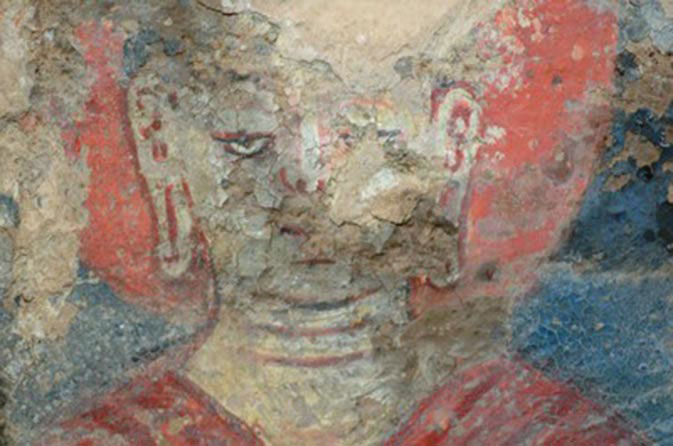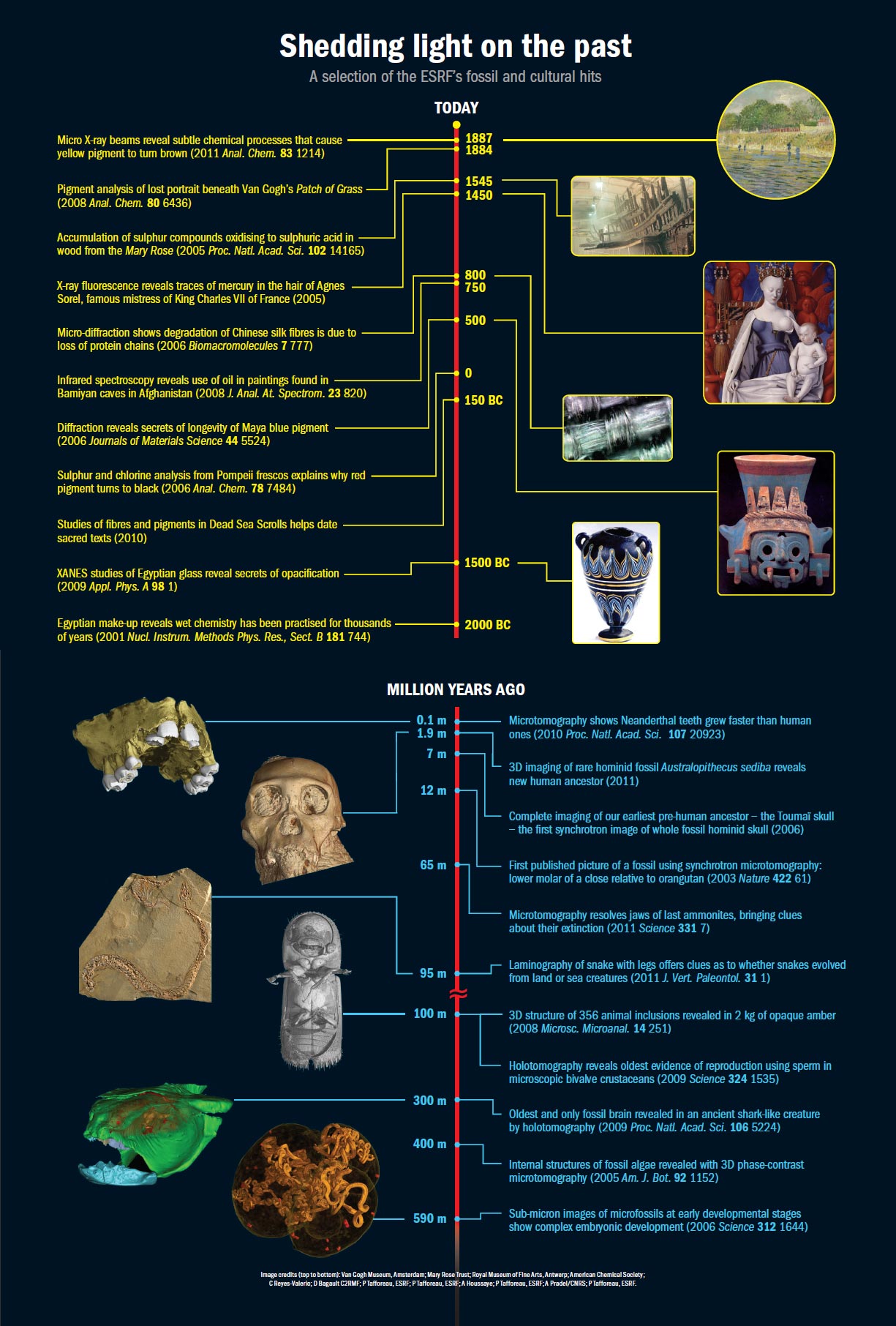- Home
- News
- General News
- Illuminating the...
Illuminating the past
20-06-2011
Fossils and artefacts offer rare glimpses of our evolutionary and cultural origins. The ESRF brings them to life at the micro-scale and is tooling up for a second decade of success.
Paul Tafforeau opens a black, foam-padded flight case and retrieves a heavy stone cylinder about 30 cm long. It looks like a log of solid rock, but it’s probably the only fossil of its kind in the world. On screen in the experimental hutch at the ESRF’s ID19 beamline, Tafforeau pulls up a preliminary 3D image of what’s inside: a stunning picture of two complete, interwoven skeletons from different creatures. What happened 250 million years ago that caused this pair, one terrestrial and one aquatic, to die in each other’s limbs? He can’t say too much yet.
Ancient objects have long been subjected to laboratory analysis by scientists and historians striving to identify our ancestors through fossils or uncover ancient trade routes through artefacts. The value of synchrotrons to archeometry wasn’t noticed until 1986 but they, and the ESRF in particular, are now routinely producing scientific papers in top journals. Traditionally, fossils were studied by slicing up them up with a diamond saw. But whole fossils can now be placed directly in the ID19 or ID17 beamlines and subjected to non-invasive techniques that yield remarkable 3D images. Similar micro-scale techniques reveal the chemical composition of cultural artefacts, how they were made and how we can preserve them.
Cultural-heritage research is good for the ESRF’s public profile – and for Europe, where annual income from heritage is estimated to generate over €300 bn in trade and services.
Spinning out
Mathematical and experimental tricks that allow fossils up to 20 cm across to be imaged with a relatively low-energy beam have benefited materials science and recently boosted industry use of the ID19 beamline. The ageing of cultural artefacts, meanwhile, gives access to timescales vastly longer than any laboratory can offer. Studying the corrosion of very old metal-based artefacts, for instance, may help researchers to design containers that can store waste safely for thousands of years. Some leading glass manufacturers are interested in the methods used at the ESRF to study Egyptian and Roman glasses, the properties of which are governed by a sophisticated nanotechnology.
 |
The ESRF shows Bamiyan cave paintings made of oil, hundreds of years before the technique was supposedly invented in Europe (Credit: National Research Institute for Cultural Properties, Tokyo). |
It wasn’t envisaged that palaeontology or cultural heritage would become such a major part of the ESRF’s portfolio, but a powerful model has been built by matching state-of-the-art beamlines with high-level, in-house expertise, and other facilities are following suit. “SOLEIL has gone as far as building a dedicated institute for cultural heritage and palaeontology, although the ESRF currently has more activity in this area than anyone else,” says ESRF’s head of instrumentation and services Jean Susini.
ID19 is to be refurbished with even better optical components to improve beam quality and manipulation, while the biomedical beamline ID17 where large fossils such as hominid skulls have been imaged will also be upgraded with a new sample stage and detector dedicated to high-quality microtomography. There are plans for a dedicated palaeontology suite in the ESRF’s main building plus a new computing facility to speed up tomography reconstruction, and this year hominid fossil images were added to the ESRF’s open-access fossil-image database (see below).
Several beamlines are already well equipped for cultural-heritage studies, offering complimentary techniques from imaging to high-energy diffraction and X-ray spectroscopy. Because cultural heritage specialists rarely interact with synchrotron scientists, it can be difficult for less familiar methods such as X-ray absorption spectroscopy to be adopted. “Existing resolutions of 1 micron – 100 nm is likely the right scale because it targets individual layers in paintings or crystals in glass,” says Susini. “But specific areas will be helped by the development of nanobeams at the ESRF.”
As ESRFnews went to press, ceramics from the Louvre and da Vinci’s artistic techniques were among proposals lining up for ESRF beam time. These and the mysteries of Tafforeau’s tandem fossil will no doubt soon be on a news stand near you.
Open-access fossils: byte-sized information
Micro-computed tomography scans allow internal structures and 3D morphologies to be viewed at increasingly finer resolutions, and they are the reason why palaeontology consumes over half of the ESRF’s computing resources. In 2009, the ESRF launched a free online database of fossil scans that have been carried out there, limiting repetitive use of fragile specimens and promoting scholarly exchange.
According to the ESRF’s Paul Tafforeau, who developed the open-access database, such digital data may represent the primary evidence of new species, given the ESRF discovery of new fossil insects in opaque amber. Select scans of these weird creatures can be viewed, as can prehistoric embryos and in April this year a new paleoanthropology section was launched containing scans of hominin dental remains.
Negotiations are currently under way to add scans performed at the ESRF in collaboration with other scholars and repositories.
Check out your ancestors’ teeth at http://paleo.esrf.eu.
Related items
 |
Matthew Chalmers
This article appeared in ESRFnews, June 2011.
To register for a free subscription and to rapidly receive the current issue, please go to:
http://www.esrf.fr/UsersAndScience/Publications/Newsletter/esrfnewsdigital
Top image: Microtomographic data of Homo sapiens fossil remains, now available to view online at paleo.esrf.eu (Credit: Paul Tafforeau).



